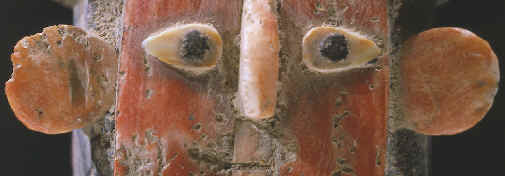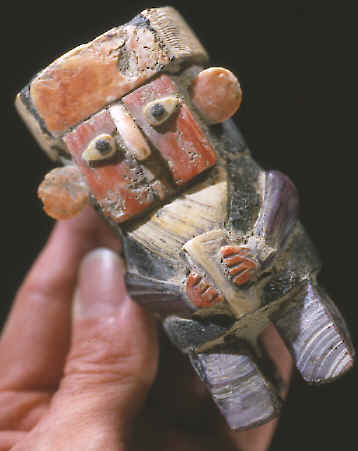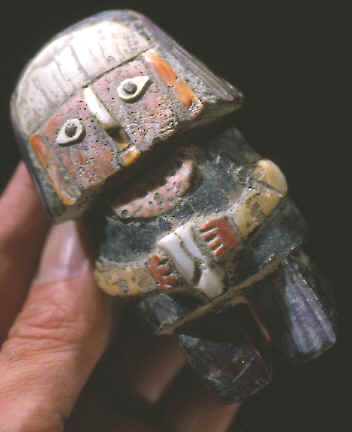|
INCA
CULTURE
CARVED
WOOD HUMAN FIGURES
INLAID WITH SHELL

FACE OF A SHELL INLAID MALE HUMAN FIGURE
INCA CULTURE
|
|
|
|
|
The Inca culture
establishes itself as a very large centralized empire by around
A.D.1438. By the early 1500's their empire enveloped an area along
western South America that stretched for 2,485 miles (4,000 km).
|
|

CLICK ON
PICTURE FOR VERY LARGE IMAGE
MALE HUMAN FIGURE
INCA CULTURE---CUZCO, PERU
PRIVATE COLLECTION
This brightly colored figure of a male human was carved out of wood
and covered on all sides with inlaid shells of various colors. He
has a pleasant looking expression but his ears seem to large but
they may actually represent ear spools instead. He is holding
some type of object in his two hands and in the side view he appears
to be kneeling with a offering. |
|
|
The ancient city of
Cuzco in south central Peru was once the capital of the Inca state. It
was here that the Inca religion reach its highest expression and where
the ruling Inca, known as the "sun of the sun", resided.
|
|

CLICK ON
PICTURE FOR VERY LARGE IMAGE
FEMALE HUMAN FIGURE
INCA CULTURE---CUZCO, PERU
PRIVATE COLLECTION
This female human figure is very similar to the male figure pictured
above. It's only slightly smaller and appears to be holding the same
object in her two hands. There are no ears or ear spools on this
figure and there seems to be hair rather than a hat which the male
is wearing. This figure is also carved out of wood and covered on
all sides with brightly colored inlaid shell. |
|
|
The Inca culture is
known for its large system of roads. It's believed that the Inca ruler
could receive dispatches from Quito by runners who could relay these
messages across a distance of 1,865 miles (3,000 km) within a week. By
the year A.D. 1532 the Inca empire had become the largest pre-Hispanic
empire in the Americas. 1532 is also the year that the Spaniards under
Francisco Pizarro destroyed it.
|
|
"REFERENCES"
1996,
"The Oxford Companion To Archaeology", by Brian M. Fagan, pp.
340-348.
1997, "Past Worlds, Atlas Of Archaeology", Harper Collins, p.
20.
1969, "Discovering Man's Past In The Americas", By George E.
Stuart & Gene S. Stuart, p. 171.
|
|
HOME
ORDERING |